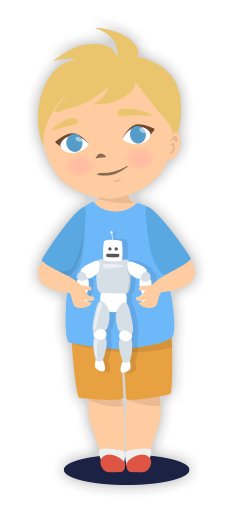At 12 Months:
- Waves “bye-bye”
- Calls a parent “mama” or “dada” or another special name
- Understands “no” (pauses briefly or stops when you say it)
At 15 Months:
- Tries to say one or two words besides “mama” or “dada,” like “ba” for ball or “da” for dog
- Looks at a familiar object when you name it
- Follows directions given with both a gesture and words. For example, he gives you a toy when you hold out your hand and say, “Give me the toy.”
- Points to ask for something or to get help
At 18 Months:
- Tries to say three or more words besides “mama” or “dada”
- Follows one-step directions without any gestures, like giving you the toy when you say, “Give it to me.”
At 24 Months:
- Points to things in a book when you ask, like “Where is the bear?”
- Says at least two words together, like “More milk.”
- Points to at least two body parts when you ask him to show you
- Uses more gestures than just waving and pointing, like blowing a kiss or nodding yes
At 30 Months:
- Says about 50 words
- Says two or more words together, with one action word, like “Doggie run”
- Names things in a book when you point and ask, “What is this?”
- Says words like “I,” “me,” or “we”
At 12 Months:
- Teach your baby “wanted behaviors.” Show her what to do and use positive words or give her hugs and kisses when she does it. For example, if she pulls your pet’s tail, teach her how to pet gently and give her a hug when she does it.
- Talk or sing to your baby about what you’re doing. For example, “Mommy is washing your hands” or sing, “This is the way we wash our hands.”
- Build on what your baby tries to say. If he says “ta,” say “Yes, a truck,” or if he says “truck,” say “Yes, that’s a big, blue truck.”
- Redirect your baby quickly and consistently by giving her a toy or moving her if she is getting into things you don’t want her to get into. Save “no” for behaviors that are dangerous. When you say “no,” say it firmly. Do not spank, yell, or give her long explanations.
- Give your baby safe places to explore. Baby-proof your home. For example, move sharp or breakable things out of reach. Lock away medicines, chemicals, and cleaning products. Save the Poison Help Line number, 800-222-1222, in all phones.
- Respond with words when your baby points. Babies point to ask for things. For example, say “You want the cup? Here is the cup. It’s your cup.” If he tries to say “cup,” celebrate his attempt.
- Point to interesting things you see, such as a truck, bus, or animals. This will help your baby pay attention to what others are “showing” him through pointing.
- Limit screen time (TV, tablets, phones, etc.) to video calling with loved ones. Screen time is not recommended for children younger than 2 years of age. Babies learn by talking, playing, and interacting with others.
- Give your baby water, breast milk, or plain milk. You don’t need to give your baby juice, but if you do, give 4 ounces or less a day of 100% fruit juice. Do not give your baby other sugary beverages, such as fruit drinks, soda, sports drinks, or flavored milks.
- Help your baby get used to foods with different tastes and textures. Foods can be smooth, mashed, or finely chopped. Your baby might not like every food on the first try. Give your baby a chance to try foods again and again.
- Give your baby time to get to know a new caregiver. Bring a favorite toy, stuffed animal, or blanket to help comfort your baby.
- Give your baby pots and pans or a small musical instrument like a drum or cymbals. Encourage your baby to make noise.
At 15 Months:
- Help your child learn to speak. A child’s early words are not complete. Repeat and add to what he says. He may say “ba” for ball and you can say “Ball, yes, that’s a ball.”
- Tell your child the names of objects when he points to them and wait a few seconds to see if he makes any sounds before handing it to him. If he does make a sound, acknowledge him, and repeat the name of the object. “Yes! Cup.”
- Find ways to let your child help with everyday activities. Let her get her shoes to go outside, put the snacks in the bag for the park, or put the socks in the basket.
- Have steady routines for sleeping and feeding. Create a calm, quiet bedtime for your child. Put on his pajamas, brush his teeth, and read 1 or 2 books to him. Children between 1 and 2 years of age need 11 to 14 hours of sleep a day (including naps). Consistent sleep times make it easier!
- Show your child different things, such as a hat. Ask him, “What do you do with a hat? You put it on your head.” Put it on your head and then give it to him to see if he copies you. Do this with other objects, such as a book or a cup.
- Sing songs with gestures, such as “Wheels on the Bus.” See if your child tries to do some of the actions.
- Say what you think your child is feeling (for example, sad, mad, frustrated, happy). Use your words, facial expressions, and voice to show what you think she is feeling. For example, say “You are frustrated because we can’t go outside, but you can’t hit. Let’s go look for an indoor game.”
- Expect tantrums. They are normal at this age and are more likely if your child is tired or hungry. Tantrums should become shorter and happen less as he gets older. You can try a distraction, but it is ok to let him have the tantrum without doing anything. Give him some time to calm down and move on.
- Teach your child “wanted behaviors.” Show her what to do and use positive words or give her hugs and kisses when she does it. For example, if she pulls your pet’s tail, teach her how to pet gently. Give her a hug when she does it.
- Limit screen time (TV, tablets, phones, etc.) to video calling with loved ones. Screen time is not recommended for children younger than 2 years of age. Children learn by talking, playing, and interacting with others.
- Encourage your child to play with blocks. You can stack the blocks and she can knock them down.
- Let your child use a cup without a lid for drinking and practice eating with a spoon. Learning to eat and drink is messy but fun!
At 18 Months:
- Use positive words and give more attention to behaviors you want to see (“wanted behaviors”). For example, “Look how nicely you put the toy away.” Give less attention to those you don’t want to see.
- Encourage “pretend” play. Give your child a spoon so she can pretend to feed her stuffed animal. Take turns pretending.
- Help your child learn about others’ feelings and about positive ways to react. For example, when he sees a child who is sad, say “He looks sad. Let’s bring him a teddy.”
- Ask simple questions to help your child think about what’s around her. For example, ask her, “What is that?”
- Let your child use a cup without a lid for drinking and practice eating with a spoon. Learning to eat and drink is messy but fun!
- Give simple choices. Let your child choose between two things. For example, when dressing, ask him if he wants to wear the red or blue shirt.
- Have steady routines for sleeping and eating. For example, sit at the table with your child when she’s eating meals and snacks. This helps set mealtime routines for your family.
- Limit screen time (TV, tablets, phones, etc.) to video calling with loved ones. Screen time is not recommended for children younger than 2 years of age. Children learn by talking, playing, and interacting with others. Limit your own screen time when you are with your child so you are able to respond to her words and actions.
- Ask your child’s doctor and/or teachers if your child is ready for toilet training. Most children are not successful at toilet training until 2 to 3 years old. If he is not ready, it can cause stress and setbacks, which can cause training to take longer.
- Expect tantrums. They are normal at this age and should become shorter and happen less often as your child gets older. You can try distractions, but it’s ok to ignore the tantrum. Give him some time to calm down and move on.
- Talk with your child by facing her and getting down to her eye level when possible. This helps your child “see” what you’re saying through your eyes and face, not just your words.
- Start to teach your child the names for body parts by pointing them out and saying things like “Here’s your nose, here’s my nose,” while pointing to her nose and your own.
At 24 Months:
- Help your child learn how words sound, even if he can’t say them clearly yet. For example, if your child says, “or nana,” say “You want more banana.”
- Watch your child closely during playdates. Children this age play next to each other, but do not know how to share and solve problems. Show your child how to deal with conflicts by helping her share, take turns, and use words when possible.
- Have your child help you get ready for mealtime, by letting him carry things to the table, such as plastic cups or napkins. Thank your child for helping.
- Give your child balls to kick, roll, and throw.
- Give toys that teach your child how to make things work and how to solve problems. For example, give her toys where she can push a button and something happens.
- Let your child play dress up with grown-up clothes, such as shoes, hats, and shirts. This helps him begin to pretend play.
- Allow your child to eat as much or as little as she wants at each meal. Toddlers don’t always eat the same amount or type of food each day. Your job is to offer her healthy foods and it’s your child’s job to decide if and how much she needs to eat.
- Have steady routines for sleeping and feeding. Create a calm, quiet bedtime for your child. Put on his pajamas, brush his teeth, and read 1 or 2 books to him. Children this age need 11 to 14 hours of sleep a day (including naps). Consistent sleep times make it easier.
- Ask your child’s doctor and/or teachers about toilet training to know if your child is ready to start. Most children are not able to toilet train until 2 to 3 years old. Starting too early can cause stress and setbacks, which can cause training to take longer.
- Use positive words when your child is being a good helper. Let him help with simple chores, such as putting toys or laundry in a basket.
- Play with your child outside, by playing “ready, set, go.” For example, pull your child back in a swing. Say “Ready, set….”, then wait and say “Go” when you push the swing.
- Let your child create simple art projects with you. Give your child crayons or put some finger paint on paper and let her explore by spreading it around and making dots. Hang it on the wall or refrigerator so your child can see it.
At 30 Months:
- Encourage “free play,” where your child can follow her interests, try new things, and use things in new ways.
- Use positive words and give more attention to behaviors you want to see (“wanted behaviors”), than to those you don’t want to see. For example, say “I like how you gave Jordan the toy.”
- Give your child food choices that are simple and healthy. Let him choose what to eat for a snack or what to wear. Limit choices to two or three.
- Ask your child simple questions about books and stories. Ask questions, such as “Who?” “What?” and “Where?”
- Help your child learn how to play with other children. Show him how by helping him share, take turns, and use his “words.”
- Let your child “draw” with crayons on paper, shaving cream on a tray, or chalk on a sidewalk. If you draw a straight line, see if she will copy you. When she gets good at lines, show her how to draw a circle.
- Let your child play with other children, such as at a park or library. Ask about local play groups and pre-school programs. Playing with others helps him learn the value of sharing and friendship.
- Eat family meals together as much as you can. Give the same meal to everyone. Enjoy each other’s company and avoid screen time (TV, tablets, and phones, etc.) during meals.
- Limit screen time (TV, tablets, phones, etc.) to no more than 1 hour per day of a children’s program with an adult present. Children learn by talking, playing, and interacting with others.
- Use words to describe things to your child, such as big/small, fast/slow, on/off, and in/out.
- Help your child do simple puzzles with shapes, colors, or animals. Name each piece when your child puts it in place.
- Play with your child outside. For example, take your child to the park to climb on equipment and run in safe areas.
- Allow your child to eat as much or as little as she wants at each meal. Your job is to offer her healthy foods and it’s your child’s job to decide if and how much she wants to eat.
- Is there anything your toddler does or does not do that concerns you?
- Has your toddler lost any skills he/she once had?
- Does your toddler have any special healthcare needs or was he/she born prematurely?
If your toddler is not meeting one or more milestones, has lost skills he or she once had, or you have other concerns, act early. Talk with your toddler’s doctor, share your concerns, and ask about a developmental screening.
If you or the doctor are still concerned:
- Ask for a referral to a specialist who can evaluate your toddler more.
- If the evaluation still shows concerns call your state Early Intervention program to find out if your toddler can get services to help. Learn more and find the number at Missouri First Steps Program.
What's Next?
Download the Milestone Tracker app today!
Track your child’s milestones from age 2 months to 5 years with the CDC’s easy-to-use illustrated checklists; get tips from the CDC for encouraging your child’s development; and find out what to do if you are ever concerned about how your child is developing. Photos and videos in this app illustrate each milestone and make tracking them for your child easy and fun.













